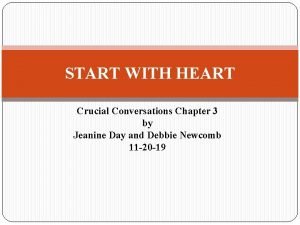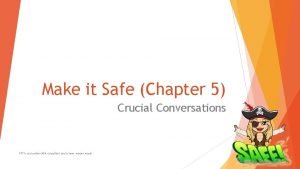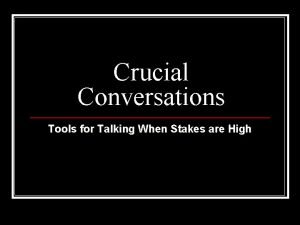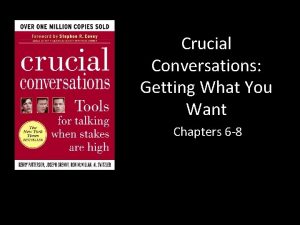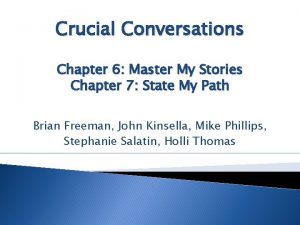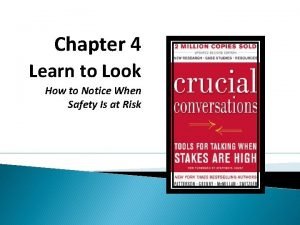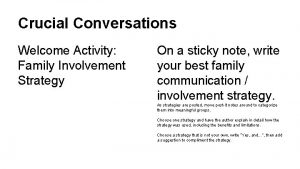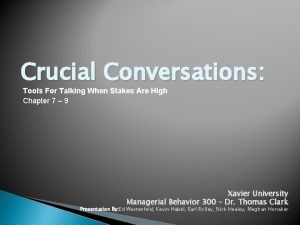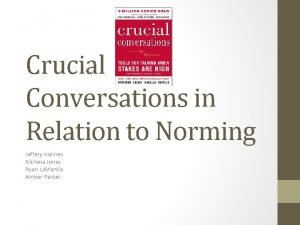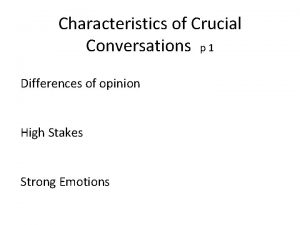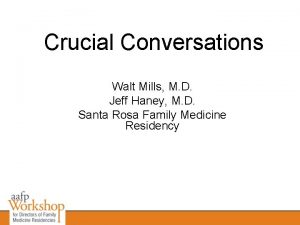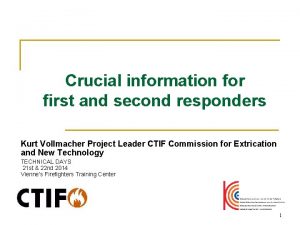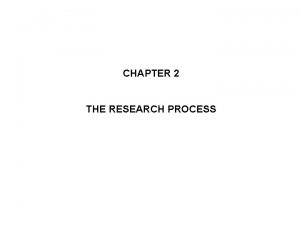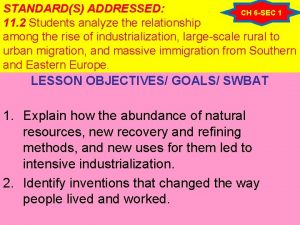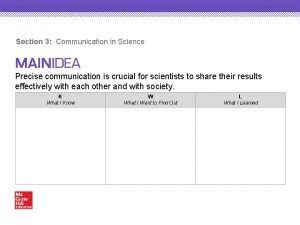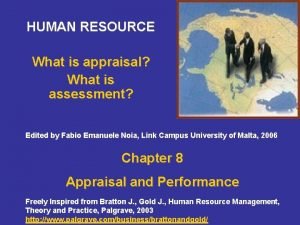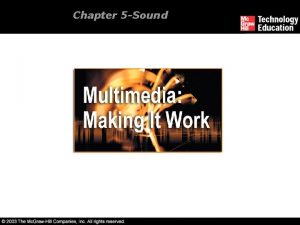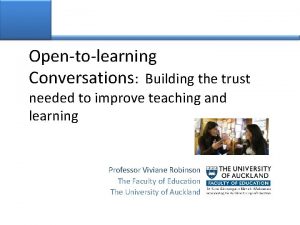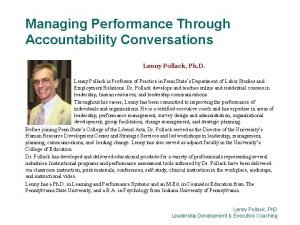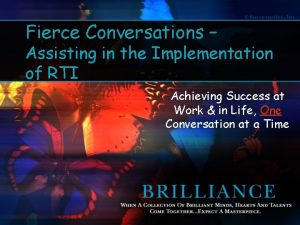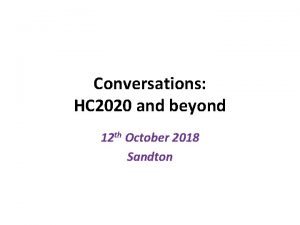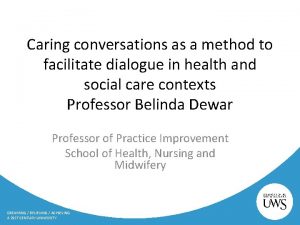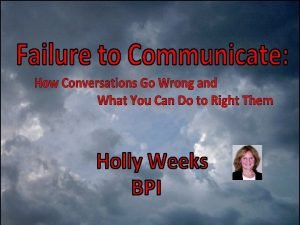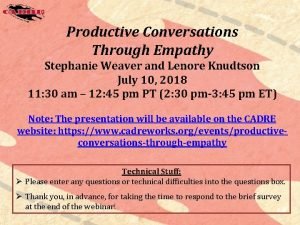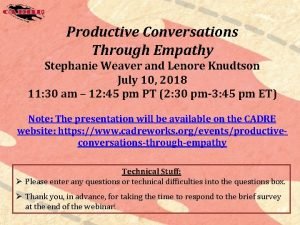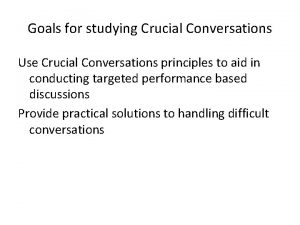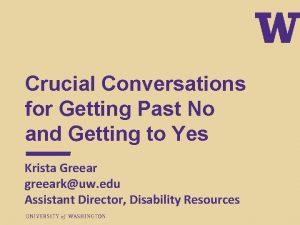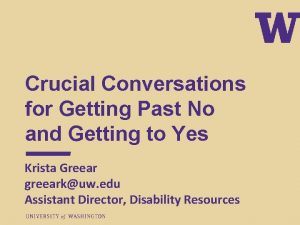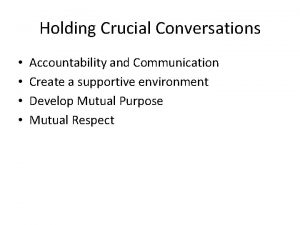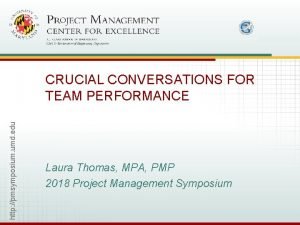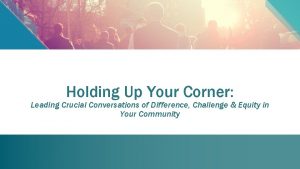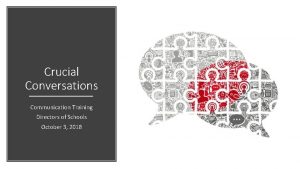Crucial Conversations Chapters 3 and 4 Kim Prather




































- Slides: 36

Crucial Conversations Chapters 3 and 4 Kim Prather, Angela Vaske, Lamin Ceesay 1

Chapter 3 The 1 st principle of dialogue is. . . START WITH HEART that is, your own heart! 2

Chapter 3 – Start With Heart Start with yourself Look inward Make the conscious effort to consider changing your way of thinking - Michael Jackson As much as others may need to change, the only person who can grow successfully is the person staring back at you in the mirror. 3

Chapter 3 – Start With Heart If you can't get yourself right, you'll have a difficult time getting dialogue right. It is important to recognize the natural physiological responses and learned behaviors which make dialogue difficult. 4

Chapter 3 – Start With Heart Work on you 1 st • 1 st step is to identify that others are not the source of our problem Work on Us 2 nd • Turn the logic around, to work on “Us” is to start with yourself 5

Chapter 3 – Start With Heart 6

Chapter 3 – Start With Heart Moment of Truth After a meeting with her boss to discuss projects left incomplete by a former employee a current employee, Michael noticed a post it note on Kim's desk with a list of task assigned to him. These tasks had been assigned to him as a result of moving into the former employees role. He approached Kim stating "I noticed you and Dan have a list going of my unfinished projects. Do you think I'm not getting my work done? Why haven't you talked with me about this before going to upper management about it? " 7

Chapter 3 – Start With Heart WARNING: Behaviors to Avoid Winning Wanting to win Punishing Seeking revenge Keeping the peace Wanting to remain safe 8

Chapter 3 – Start With Heart WARNING: Behaviors to Avoid Kim's first impulse is to keep the peace – tell Michael this list is no big deal and everything is fine. Don't worry! I would never go behind your back to talk about your performance with our superior. OR To punish – How dare you tell me what I can and can't talk about in meetings with management! I'm your boss. 9

What am I doing and if I had to guess, what does it tell me about my underlying motive? Will either of those reactions result in a successful crucial conversation? 10

Chapter 3 – Start With Heart 1 st Focus on what you really want What do I really want for myself? What do I really want for others? What do I really want for the relationship? When you start to slip out of dialogue: • Refocus the brain • Find your bearings • Take charge of your body 11

Chapter 3 – Start With Heart 1 st Focus on what you really want What do I really want for myself? To have these critical projects completed accurately and quickly. To help Michael develop into a more dependable and competent project leader than his predecessor. What do I really want for others? For Michael to have adequate support and training to be able to get these tasks completed. To avoid Michael inheriting the poor reputation of the person in his job previously. To increase Michael's confidence so he can be trusted by myself and others to complete critical projects with minimal oversight. What do I really want for the relationship? To maintain a positive working relationship, to stay fully informed of automation developments and to have clear, reachable goals. To have a working relationship where I can be relied upon to "pick up the slack" when needed rather than having projects fall off the radar and go uncompleted. 12

Chapter 3 – Start With Heart Refuse the Fool’s Choice • 1 st, clarify what you really want • 2 nd, clarify what you really don’t want • 3 rd, present your brain with a more complex problem 13

Chapter 3 – Start With Heart Refuse the Fool’s Choice • What I really want is to have these projects completed and to have Michael perform better than the person previously in his job. What I don't want is for Michael to think he was expected to know everything on day one and proceed without the necessary support. • Is there a way for me to tell him my concerns about missing future deadlines and make sure he isn't feeling that I don't support him? 14

Chapter 3 – Start With Heart What happened: Michael approached Kim about the post-it note of his incomplete projects feeling that she hadn't given him a chance before going to upper management about the issues. Kim responded: "This is a list of projects I need to make sure you have support to get done. What I don't want is for you to feel you need to know everything on day one without any training or support. What I do want is for these projects to be completed as soon as possible. What do you need from me to make that happen? " The two proceeded to have a discussion about prioritizing some things over others and delegating some tasks to lower level employees in order to free up time for Michael to get training and to focus on critical items. 15

Chapter 3 – Start with Heart then Chapter 4 – Learn to Look We learned that the one person to motivate change is yourself. To continue forward in this journey one must "Learn to Look" when entering dialogue. 16

Chapter 4 Learn to Look 17

Chapter 4 – Learn To Look Notice when safety is at risk. Return conversations to safety. 18

Chapter 4 – Learn To Look Watch for conditions: Avoid focusing only on the content – see what is happening to the people in the conversation. How are they reacting? Is it safe? 19

Chapter 4 – Learn To Look Learning to spot when a conversation becomes crucial: Physical symptoms? Emotional response? Behavioral response? 20

Signs you are slipping out of dialogue: Look for Physical clues that tell you a conversation has just turned from routine to crucial. Is your stomach tightening? Hands sweating? Mouth dry? Are you noticing your own emotions running strong? Fear? Anger? Hurt? What kind of behavior are you exhibiting? Raising your voice? Pointing fingers? Going silent? Looking at the floor? 21

What has happened to safety? 22

Chapter 4 – Learn To Look • You notice yourself or others withholding or using the silent treatment to avoid content: • You feel you are being attacked: • Recognize others do not feel safe. 23

Chapter 4 – Learn To Look • "We're asking you to recode silence and violence as signs people are feeling unsafe. • We're asking you to fight your natural tendency to respond in kind. • We're asking you to undo years of practice maybe even eons of genetic shaping that prod you to take flight or pick a fight (when under attack), and recode the stimulus. " 24

Silence Any act that intentionally withholds information from the pool of meaning. 25

Masking • Sarcasm • Sugar coating • Couching Avoiding • Changing the subject entirely rather than have the conversation Withdrawing • Exiting the conversation • Exiting the room 26

Silence video – Big Bang Theory https: //www. youtube. com/watch? v=IYdterxi. QEU 27

Violence Verbal strategy intended to convince, control or compel others to your point of 28 view.

Controlling • Forcing your view • Dominating the conversation Labeling • Putting a person or idea into a stereotypical category in order to dismiss Attacking • Belittling • Threatening • Wanting to make the person suffer 29

30

Don’t Forget: YOUR style under stress Don't fail to monitor your own behavior, remember, you are the only person you can control. What are you doing and what impact are you having? Watch to see if you are having a good or bad impact on safety. 31

Angela's personal example –Failed CC Attending a routine team conference call. Role call is taking place and three additional attendees are there. Two senior Managers and HR. Immediately, I knew immediately stakes were high and 5 minutes later when I realized my career and personal livelihood was impacted the emotions ran high. I started in silence for about 90 seconds until I moved to violence. I was sick to my stomach, I was visibly shaking, and I was very angry. Not for all of the reasons you may think. I still had a position if I wanted to stay. how was conversation returned to safety. I did not recognize my conditions & how know way to get to safety. My violence stirred the pot with my soon to be new manager. Who was the reason for my reaction. 32

Chapter 4 – Learn To Look • Are you good at self monitoring? • Are you good at conversation when it becomes crucial? If you aren't sure then find out and take the survey to understand your Style Under Stress. Once you identify your style under stress you can then "Learn to Look". 33

Angela's personal example –Failed CC ? Not anymore. . . My analysis after learning the tools I stop to recognize the dialogue and how all parties might be affected. My Style Under Stress today is much more level headed. Once I was able to learn these strategies I earned that I did not behave correctly in that situation. It wasn't until this year because of this course that I recently apologized and spoke to my Senior Manager about that day and realized the errors in my approach and that I knew she understood my position that day. 34

Lamin's personal example I successfully faced a crucial conversation and, using the skills and verbal strategies from Crucial Conversations, I was able to convince my boss perception that I was not doing my work and concentrating on school homework. I worked at a distribution center and our main focus was on time delivery. On this day I walked into the facility and walked into the conference room for a scheduled meeting with the Plant Manager. His facial expression was unfriendly, verbally blunt, and short on patience. He and I had developed a culture of mutual respect over the years because our good work ethic. But now, here I am being summoned for not doing my work! So, there we were. The conversation just turned crucial. I was facing someone whose next words would determine if I would stay or leave the company. What should I do? ? Speak up to save my conscience? I wanted to deny the accusations peddled on me —but risked offending him. Understanding that he would not feel defensive if he felt safe with me, I tried to reassure him that I am still the same workaholic he knew. By reassuring him that I respected his position, I helped him avoid the need to demonstrate his power by shutting me down. By communicating that I cared about his need for quick results, I helped him avoid the need to advance that value by ignoring the company's goal of achieving onetime delivery. If you had been in the room with me you would have noticed the immediate change in his body language. He shrunk back down to normal size. He leaned back again in his chair. And his face relaxed. I knew he felt safe, so I knew I have candidly addressed his concern. Returning the conversation to safety leads to a successful crucial conversation. 35

Chapter 4 – Learn To Look Learn to look at context and conditions Look for when things become crucial Learn to watch for safety problems Look to see if others are moving to silence or violence Look for outbreaks of you Style Under Stress 36
 Start with heart
Start with heart Constructive structure in asl
Constructive structure in asl Difficult conversations ppt
Difficult conversations ppt Contrasting statements crucial conversations examples
Contrasting statements crucial conversations examples Crucial conversations chapter 6 summary
Crucial conversations chapter 6 summary Crucial conversations
Crucial conversations Crucial conversations path to action
Crucial conversations path to action Crucial conversations chapter 4
Crucial conversations chapter 4 Crucial conversations role play examples
Crucial conversations role play examples Crucial conversations triangle
Crucial conversations triangle Ampp crucial conversations
Ampp crucial conversations Crucial conversations
Crucial conversations Crucial conversations
Crucial conversations Crucial conversations 7 principles
Crucial conversations 7 principles Cruicial conversations
Cruicial conversations Crucialconversations.com/exclusive mutual respect
Crucialconversations.com/exclusive mutual respect Kristala l. j. prather
Kristala l. j. prather Natasha webb prather
Natasha webb prather Hays county district clerk
Hays county district clerk Dr brad prather
Dr brad prather The detectives need more time to inquire
The detectives need more time to inquire Kurt crucial
Kurt crucial What processes are crucial to the ipde process
What processes are crucial to the ipde process Which resources played crucial roles in industrialization?
Which resources played crucial roles in industrialization? Why is precise communication crucial in science
Why is precise communication crucial in science Performance management is crucial to ______.
Performance management is crucial to ______. Crucial systems
Crucial systems Crucial aspects of preparing digital audio files
Crucial aspects of preparing digital audio files Open to learning conversations viviane robinson
Open to learning conversations viviane robinson Accountability conversations
Accountability conversations Fierce conversations 7 principles
Fierce conversations 7 principles Fierce conversations 7 principles
Fierce conversations 7 principles Caring conversations framework
Caring conversations framework Types of difficult conversations
Types of difficult conversations Can we have conversations
Can we have conversations Productive conversations take real empathy
Productive conversations take real empathy Stephanie weaver md
Stephanie weaver md
